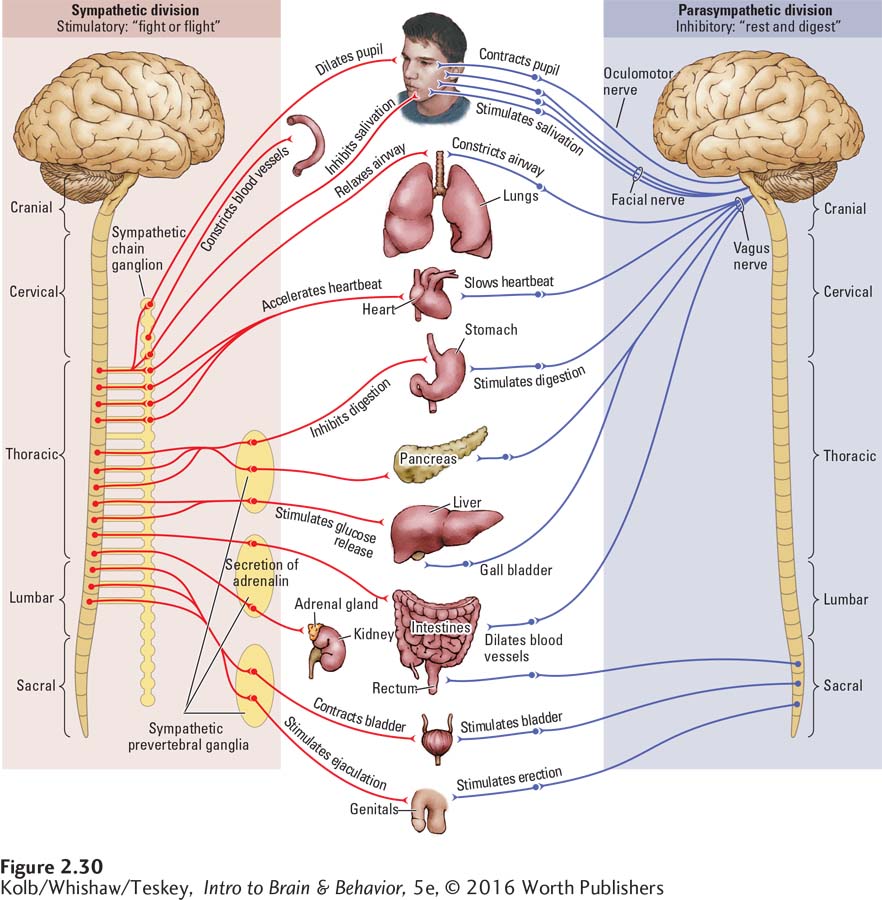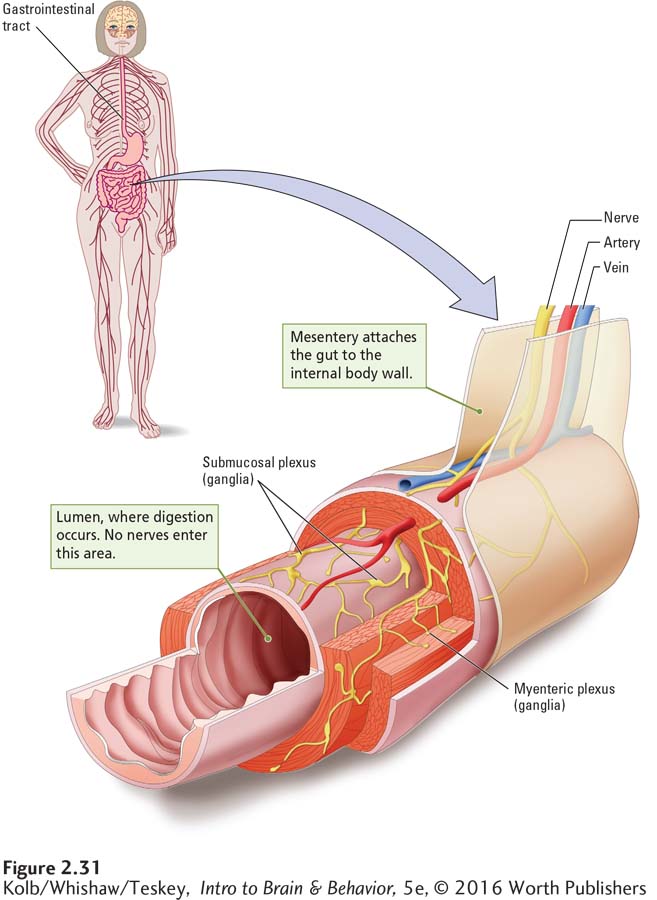2-5 Autonomic and Enteric Nervous Systems: Visceral Relations
Control of the viscera (internal organs), including the heart, gut, liver, and lungs, requires complex neural systems. Yet the ANS and ENS are hidden partners, functioning in the background as the CNS controls our perceptions and behaviors. If we had to focus consciously on visceral activities, we would do little else. The ANS and ENS interact with the CNS, but each has distinctive anatomy and functions.
ANS: Balancing Internal Functions
Section 5-3 explains CNS–
Without our conscious awareness, the ANS stays on the job to keep the heart beating, the liver releasing glucose, the pupils of the eyes adjusting to light, and so forth. Without the ANS, which regulates the internal organs and glands via connections through the SNS to the CNS, life would quickly cease. Although learning to exert some conscious control over some of these vegetative activities is possible, such conscious interference is normally unnecessary. An important reason is that the ANS must keep working during sleep, when conscious awareness is off duty. But gastrointestinal disorders are common, and stress is often a factor. Psychological therapies are often effective in treating such disorders.
It is tempting to think that the ANS’s organization must be pretty simple because it functions outside our conscious awareness. Yet, like the SNS, we can think about the ANS as a collection of minibrains with a surprisingly complex organization. The two ANS divisions work in opposition. The sympathetic division arouses the body for action, for example, by stimulating the heart to beat faster and inhibiting digestion when we exert ourselves during exercise or times of stress—
Principle 10: The nervous system works by juxtaposing excitation (increased neural activity) and inhibition (decreased neural activity).
Like the SNS, the ANS interacts with the rest of the nervous system, and like the SNS, ANS connections are ipsilateral. Activation of the sympathetic division starts in the thoracic and lumbar spinal cord regions. But the spinal nerves do not directly control the target organs. Rather, the spinal cord is connected to autonomic control centers—
The sympathetic ganglia are near the spinal cord on each side, forming chains that run parallel to the cord, as illustrated at left in Figure 2-30 for one set of ganglia. The parasympathetic division also is connected to the spinal cord—

ENS: Controlling the Gut
64
The ENS is sometimes considered part of the ANS, but it functions largely independently. Digestion is complicated, and evolution has provided this dedicated nervous system to control it. Some scientists have even proposed that the CNS evolved from the gut of very simple organisms.
In fact, the ENS is sometimes called the second brain because, like the CNS, it contains a diversity of neuron types, the same chemical transmitters, a profusion of glial cells, and complex integrated neural circuits. Its estimated 200 million to 500 million neurons roughly equals the number in the spinal cord. The gut reacts to a range of hormones and other chemicals with exquisite neural responses. The ENS functions to control bowel motility, secretion, and blood flow to permit fluid and nutrient absorption and to support waste elimination (see Avetisyan et al., 2015). This is no simple task, given the number and balance of nutrients needed to support the body.
Section 12-4 expands on how emotions and the ENS interact, Section 12-5 on the ENS and eating.
65
ENS neurons are located in a sheet of tissue (plexus) lining the esophagus, stomach, small intestine, and colon. As shown in Figure 2-31, ENS neurons and glia form ganglia connected by nerve fibers found in two layers of gut tissue. The brain and ENS connect extensively through the ANS, especially via the vagus nerve. Although we are not conscious of our gut “thinking,” the ENS sends information directly to the brain—

The ENS interacts with gut bacteria, known collectively as the microbiome. About 1014 microbiota populate the adult gut, outnumbering the host cells by a factor of 10 (Farmer et al., 2014). The microbiota influence nutrient absorption and are a source of neurochemicals that regulate an array of physiological and psychological processes. This relationship has inspired the development of a class of compounds known as psychobiotics, live microorganisms used to treat behavioral disorders. Thus, the microbiota can influence both the CNS and ENS, leading to changes in behavior.
66
2-5 REVIEW
Autonomic and Enteric Nervous Systems: Visceral Relations
Before you continue, check your understanding.
Question 1
The ANS interacts with the CNS and SNS via sets of autonomic control centers called __________, which act as minibrains to control the internal organs.
Question 2
The __________ division of the ANS arouses the body for action, and the __________ division calms the organs. The two divisions work __________ to allow for quick defensive responses (fight or flight) or to induce a calming (rest and digest) state.
Question 3
Why is the ANS essential to life?
Question 4
The ENS is often called a second brain because of the __________ it contains.
Question 5
The ENS interacts with bacteria that form the __________, which absorbs __________ and produces __________ that can regulate CNS and ENS activity.
Question 6
What are psychobiotics?
Answers appear in the Self Test section of the book.